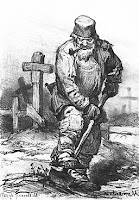Paranormal Liaisons: Rising from the Civil War's Ashes
by Troy Seate
by Troy Seate
On a sloping hill overlooking the poetically named little town of Sugar
Creek, Tennessee rests an old cemetery where, in the 19th century,
people buried their dead. The old timers call the strip of land The
Resting Place, but local legend suggests it is anything but restful. To
the east in Washington D.C., a family deals with life amidst a nation
still recovering and rebuilding from the Civil War’s debacle. Into a
mother’s life befalls the tragedy of losing a daughter. It is but one of
many unsettling events that occur, but it proves to be the linchpin for
paranormal events to follow.
These are tales of fear and confusion; horror and tragedy. It’s also about loss and betrayal, and how life’s fabric can unravel in the most shocking and tragic of ways. Two towns, one north and the other south of the Mason-Dixon Line, deal with supernatural speculation in the American Civil War’s aftermath.
These are tales of fear and confusion; horror and tragedy. It’s also about loss and betrayal, and how life’s fabric can unravel in the most shocking and tragic of ways. Two towns, one north and the other south of the Mason-Dixon Line, deal with supernatural speculation in the American Civil War’s aftermath.
Seducing the Chef - Allie Blakefield, editor of Good Eatin' wants to do a
feature on Five Cuisines a restaurant across the river from NY City.
Her father forbids the feature and won't say why. She's not one to sit
back and be ruled by someone. She borrows a friend's apartment. While
leaning over the balcony she sees a handsome dark haired man doing a
Yoga routine. He looks up and she is struck by the Blakefield curse.
Love at first sight.
The pair start a hot and heavy romantic interlude. She visits the restaurant and is recognized by Greg, the chef's mother. The woman goes ballistic and the affair is broken. Can Allie learn what's going on and rescue her love?
The pair start a hot and heavy romantic interlude. She visits the restaurant and is recognized by Greg, the chef's mother. The woman goes ballistic and the affair is broken. Can Allie learn what's going on and rescue her love?
City girl, country guy. Will opposites attract--or clash?
When New-York-City girl Emily visits her cousin Janelle in Oregon, Emily wonders how she'll survive the wilderness. Janelle wonders if the wilderness will survive Emily's visit--and if she can convince her cousin to help save part of an old-growth forest.
Meanwhile, Emily also wonders if a big-city girl can get along with a county guy--named Bret. Under forest canopies and by crystal-clear waters she struggles with her growing attraction to him. But they're so different. Whoever thought she'd fall for someone like him?
When New-York-City girl Emily visits her cousin Janelle in Oregon, Emily wonders how she'll survive the wilderness. Janelle wonders if the wilderness will survive Emily's visit--and if she can convince her cousin to help save part of an old-growth forest.
Meanwhile, Emily also wonders if a big-city girl can get along with a county guy--named Bret. Under forest canopies and by crystal-clear waters she struggles with her growing attraction to him. But they're so different. Whoever thought she'd fall for someone like him?


















